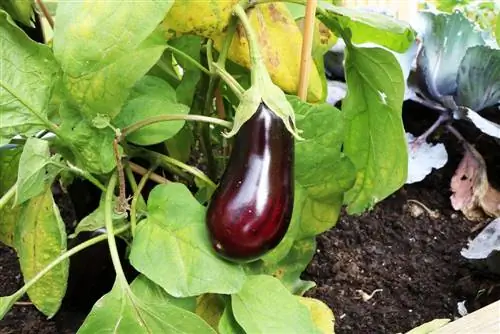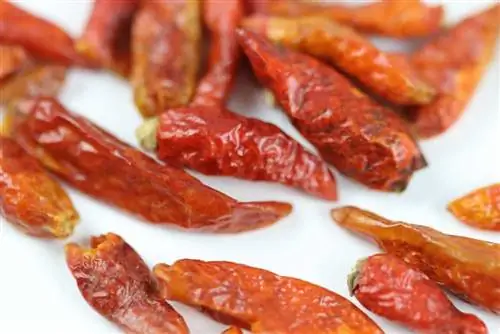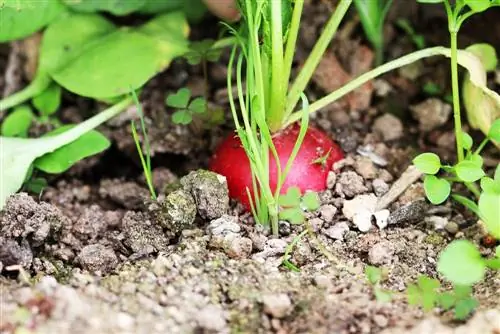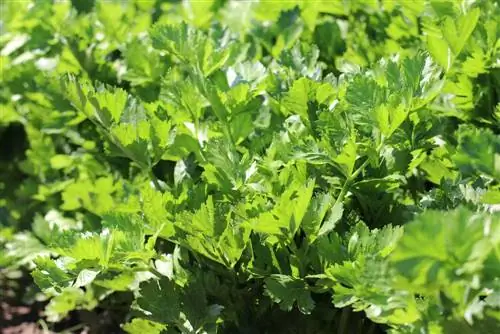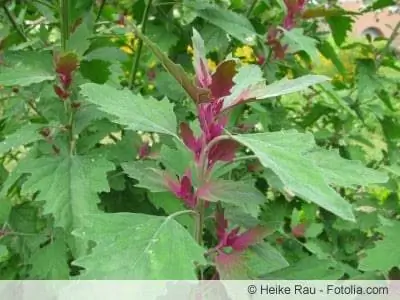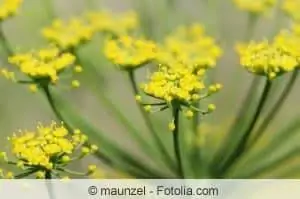- Author admin [email protected].
- Public 2023-12-17 03:39.
- Last modified 2025-06-01 06:48.
Whether stuffed or fried: eggplants are a delicacy in many ways. The subtropical vegetables have been an integral part of well-stocked fruit departments for many years. Growing and harvesting in your own garden is associated with a number of hurdles. The nightshade family reacts sensitively to various factors. The foundation for successful cultivation occurs with the sowing of Solanum melongena. With the right tips and a little preparation, you will soon be able to harvest your own “egg crops”.
Subtropical vegetables for the garden
Vitamin-rich eggplants have been an integral part of Indian cuisine for around 4,000 years. From there, the tasty egg fruits also began their triumphal march to numerous other countries. While eggplant is a standard food in Mediterranean and Turkish regions, in our latitudes the vegetable is still considered exotic in some areas. The selection of eggplant varieties is as different as the growing regions. The egg fruits differ in shape and color. In addition to spherical and elongated varieties, club-shaped, snake-shaped and teardrop-shaped fruits are known. In yellow, green, orange-red to white, purple or marbled colors, eggplants dominate the Mediterranean vegetable markets.
Solanum melongena can reach a height of between 40 and 150 cm. The upright-growing vegetable plants with hairy leaves can also be cultivated in cooler regions with a little preparation and the right care. In addition to the optimal location and care, the right sowing time also determines the success or failure of the cultivation. Due to their origin, the plants with the purple flowers require a lot of light and warmth. Direct cultivation outdoors would be possible from the end of May. However, the long development and maturation period of the plants makes harvesting impossible in this case. For this reason, the Asian vegetable perennials are sown under glass from the beginning of March.
Growing in spring
Even before the sun's rays awaken the first delicate green outdoors from hibernation, the first preparations for the upcoming garden season begin in the warm greenhouse. Temperatures of 20° to 25°C are necessary for eggplants to sprout. Alternatively, germination can also take place on a bright, warm windowsill. The basic equipment for seed cultivation includes the following components:
- propagation container
- Lean substrate
- Water Atomizer
You can get eggplant seeds from well-stocked nurseries. Growing rare varieties is not difficult, but finding the right seeds can be a challenge. Choose a warm spot near a bright window to grow. Solanum melongena depends on a lot of sunlight for the development of the tasty fruits. However, direct UV radiation can have a counterproductive effect on the seeds until they germinate. At this stage, the young plants are not yet able to adequately protect themselves. At the same time, the risk of the substrate drying out too quickly increases. Shield the growing container from sunlight during midday or choose a safe location.
- Fill lean soil into the container
- Wet sufficiently with the water sprayer
- Press the seeds 1 cm deep into the substrate
- Maintain a minimum distance of approx. 3 cm between the individual grains
- Keep the soil moist

You can use a trick to break the eggplant's germination inhibition. To do this, soak the seeds in water or chamomile tea for about 3 to 4 hours. Then sow immediately. Check the moisture content of the soil daily. If necessary, add water immediately. Common mistakes made during cultivation are due to dryness or waterlogging. Both can lead to the death of the young plants or prevent germination. Under optimal conditions, the first green shoot tips appear after approximately 21 to 25 days.
Tip:
Avoid active heating sources. For protection or insulation, you can place a thick polystyrene plate between the window sill and the cultivation container.
Mini size greenhouse
High humidity and constant temperatures accelerate the germination and growth of exotic vegetable plants. Passionate gardening enthusiasts often resort to a simple trick and put a perforated plastic film over the flower pot. This method is also sufficient for Solanum melongena, although it is tedious to remove the film for a few hours every day. This promotes air circulation and prevents rot and mold formation. With simple materials you can refine the technique without having to dig deep into your pockets. You need:
- Narrow-meshed aviary wire (rabbit mesh)
- Sturdy adhesive tape
- Transparent film
- Small wooden or plastic box
You only need a small piece of grid for the basic structure. The mesh is bent over the box like a roof and the middle should not have any direct contact with the future cultivation container. This makes it possible to grow seedlings and cuttings under the structure. Place the foil on the wire and secure it with the tape. The box serves as a growing container. Whether you place the substrate directly in it or just use the box as a container for the actual pot is up to you. You can attach the prepared top part to the fruit box. The advantage: The mini greenhouse delays the drying out of the soil and at the same time increases the humidity.
Tip:
Use artificial light for plants when there is a lack of light. This promotes growth and resilience.
Important care measures
After about 3 to 4 weeks, the seedlings will have reached a reasonable size and need to be pricked out. This measure is important and prevents the roots of the eggplants from growing inseparably together. Only after the Ice Saints in May can the vegetable plants move to their final place in the bed. Until then, you should give the young plants individual pots with humus-rich soil. When temperatures rise to 18°C outdoors during the day, you can slowly acclimate Solanum melongena to the climatic conditions in the garden.
- Protect the plants from the direct sun at first
- Keep substrate moist
- After pricking out, the eggplants are fertilized for the first time
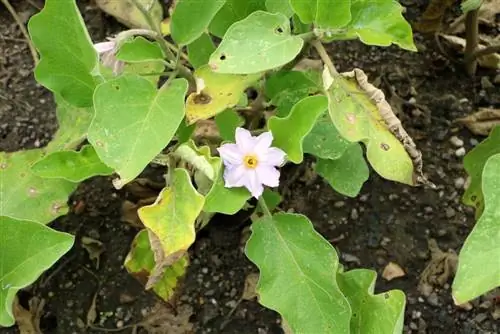
If you have a heated greenhouse, you should transplant the vegetable plants as early as April. A protected location is important in the garden. For example, proximity to walls has proven useful for this task. The stones store heat during the day and slowly release it into the surrounding area at night. Depending on the height, the perennials in this place are also protected from drafts and wind. Eggplants are more sensitive than peppers and gratefully accept such safety measures.
Conditions in the garden
Aubergines are very particular about the soil and proper care. Even small deviations or errors can cause the nightshade plants to fail and the harvest to be very low. In addition to the right substrate, the substrate must also meet certain requirements:
- Permeable
- Humus-rich
- Profound
- ph value between 5.5 - 6.5
The exotic plants have a widely branched and deep network of roots. Make preparations before planting and prepare the bed. This includes thoroughly loosening the surrounding soil with a digging fork. Only transplant the vegetable plants into the garden when the soil has warmed up. Solanum melongena cannot cope with cold feet. If necessary, pre-warm the soil with a special plant film.
- The planting hole should be twice the size of the eggplant roots
- Loosen heavy soil with quartz sand
- Lay out a thick layer of compost
- Maintain a minimum distance of approximately 60 cm between the individual perennials
- Pour vigorously
Aubergines prefer a moist substrate, but the exotics react sensitively to waterlogging. You can permanently loosen the soil with small pebbles or expanded clay balls. The inorganic materials permanently prevent the soil from compacting. At the same time, the water can drain away quickly and important oxygen reaches the roots of the plants. Fertilizer should be applied every 14 days until harvest. Commercially available liquid fertilizer has proven to be effective for this task and is administered directly via the irrigation water. Follow the package leaflet when providing nutrients. Over-fertilization can damage the plants.
Tip:
The vegetable plants need a stable climbing aid so that the shoots with the heavy fruits do not break.
Harvest

For eggplants, pollination is not carried out by insects, but by the wind. Small varieties of Solanum melongena can be cultivated in large containers. If the plants are kept on the balcony or in the greenhouse, they should be shaken regularly when they are in full bloom. In this way you ensure the fertilization of the female inflorescences so that the vitamin-rich fruits can develop. The eggplant harvest season begins at the end of July or beginning of August. Depending on the weather, this can extend into October. Cut off the fruit, including the flower base and stem, with a sharp knife so that the plant is not damaged unnecessarily.
- Strip out side shoots similar to tomatoes
- Do not harvest fully ripe fruits
- Unripe eggplants ripen to a small extent
- Storage of unripe fruits should be warm and dark
If the fruit has a shiny skin and gives slightly when pressed, it is the optimal time to harvest. You can store the vegetables in the refrigerator for about 2 weeks. Eggplants, cut into small pieces, will last for several months in the freezer. After the harvest season in October, you can tear out the plants along with the roots and dispose of them in the compost. Overwintering is not possible. To avoid diseases, the crop rotation of the site must be taken into account. In the next 3 to 4 years the substrate will be unsuitable for growing eggplants. A large-scale replacement of the soil would be necessary to avoid this waiting time.
Varieties

The exotic plants are varied. The variations mainly differ in the harvest time, fruit color and size. The most popular types of Asian plants include:
- Solanum melongena esculentum: Almost all club-shaped eggplants available in the supermarket come from this variety.
- Solanum melongena depressum: This variety produces small fruits and is widespread in Asia.
- Solanum melongena serpentinum: The term “eggplant” is no coincidence. The fruits of this eggplant variety are small and egg-shaped.
- Solanum melongena Belezza Nera: The round, large fruits with dark purple skin are an eye-catcher in the garden. The variety was nicknamed “Black Beauty”.
- Solanum melongena Prosperosa: The perennial is robust and tolerates cooler temperatures. Prosperosa has round, dark purple fruits.
- Solanum melongena Striped Toga: An extremely colorful eggplant variety. The small fruits are initially yellow-green striped and take on an orange-red color as they ripen. The taste is slightly bitter.
- Solanum melongena Bambino: A small-growing variety suitable for cultivation in planters.
- Solanum melongena Money Maker: These perennials can handle cooler temperatures. Early ripening and high-yielding variety with club-shaped, dark purple fruits.
Conclusion
The nightshade plants, which come from India, are enjoying increasing popularity among passionate hobby gardeners. However, the heat-loving plants are very particular when it comes to care, location and substrate and react very sensitively to grievances. Anyone who manages to meet all the eggplant needs can look forward to a bountiful harvest in their own garden.

